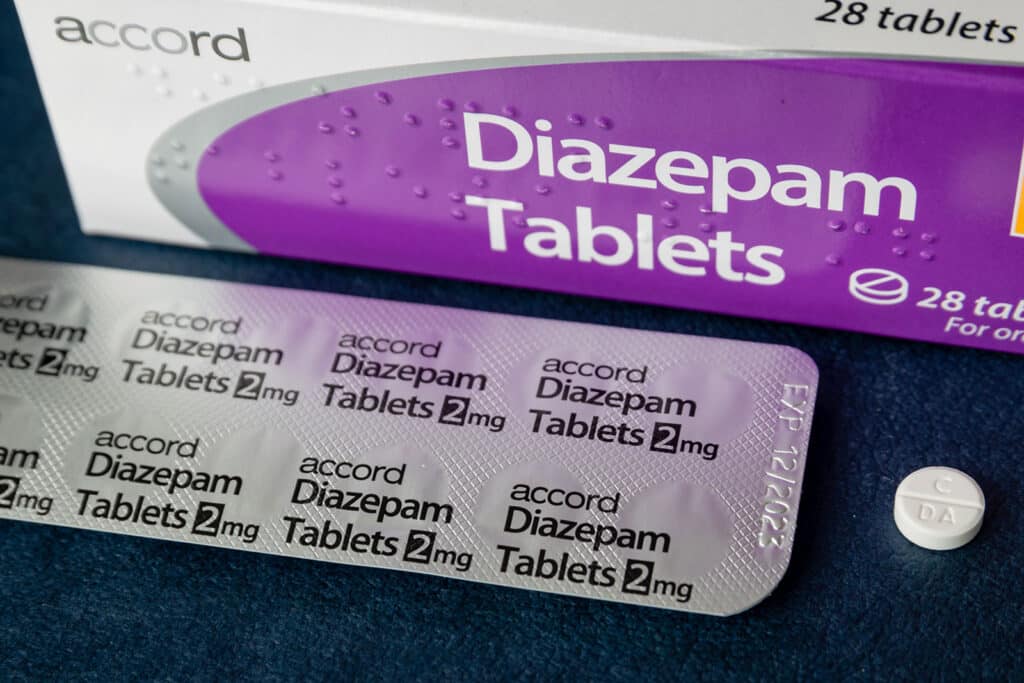Valium is a nervous depressant commonly prescribed in the United States for certain diseases and before some surgical procedures. Unfortunately, the drug has a sedative and calming effect that some people end up abusing.
This guide discusses everything you need to know about Valium, including its mechanism, addiction risk, signs & symptoms, withdrawal effects, and, most importantly, treatment.
For more information about drug and alcohol addiction, check out our blog here.
Table of Contents
Valium: An Overview
Valium, most commonly known as diazepam, is a sedative drug that belongs to the benzodiazepines family of medicines. It’s often used as a muscle relaxant and is only available through prescriptions.
Its muscle-sedating effect allows Valium to be used in treating anxiety, seizures, and tension resulting from alcohol withdrawal symptoms. It’s sometimes used before medical procedures to calm the patients as well.

The sedative effect of Valium is achieved when it affects the brain and slows down its hyperactivity.
Normally, the brain and central nervous system operate through electric signals. When a surge occurs in these signals, the person may feel anxious and restless. Prolonged brain hyperactivity may also result in insomnia.
What Valium and other benzos do is that they slow down the transmission of these electric signals to calm down the brain.
Without dwelling too much on science, benzos help an inhibitory neurotransmitter known as GABA (Gamma-aminobutyric acid) bind into its respective receptors in the brain. This enhances its calming effect and reduces anxiety.
How the Addiction Happens
The good news is that Valium isn’t as addictive as other drugs, like opioids, for example. The DEA has categorized it as a Schedule IV drug, which means it has a low potential for addiction.
The bad news is that it still provides a “high” feeling that can make people psychologically dependent on it, even if their bodies won’t show that many withdrawal symptoms if they quit.
The addiction risk starts to appear when people seek that “high” feeling by taking the prescribed medication more than intended or abusing other people’s prescriptions. Diazepam can be swallowed as tablets or crushed into pills and snorted.
Biologically speaking, the increased GABA activity dampens nerve activity in the brain, leading to feelings of relaxation and reduced anxiety.
However, it also activates the brain’s reward pathway, flooding it with dopamine. Dopamine is associated with pleasure and reinforces the desired effects of Valium.
With repeated use, the brain adapts to the presence of Valium. It downregulates GABA receptors and dopamine production, meaning the same dose no longer produces the same pleasurable or calming effects.
It also means that the dopamine secreted will no longer be enough to alleviate anxiety without the effect of Valium, a condition known as drug tolerance.
To achieve the desired feeling, the person needs to take higher doses or use Valium more frequently. This combination of tolerance and dependence creates an endless cycle of addiction.

Signs and Symptoms of Valium Addiction
Valium addiction is only to be diagnosed by a qualified professional. The diagnosis is done through the standard 5-panel drug test.
To differentiate between regular valium use and abuse, the clinician will also look through the person’s medical history, which will often include the following signs and symptoms:
Mental Effects of Valium Addiction
Here’s how Valium can affect the mentality of a dependent person:
1. Heightened Anxiety and Paradoxical Reactions
One might think Valium addiction would simply lead to constant calmness. That’s mostly true, but the opposite can often occur.
Chronic use disrupts the delicate balance of neurotransmitters in the brain, particularly GABA and glutamate, which regulate anxiety.
This can lead to a rebound effect, causing anxiety to return even worse than before (called rebound anxiety).
Additionally, according to case reports, some people experience paradoxical reactions, where Valium use actually increases anxiety or triggers feelings of anger and aggression.
2. Depression and Mood Swings
Valium addiction can significantly impact mood regulation. Disruptions in the brain’s reward system, caused by dopamine depletion, can lead to feelings of depression, anhedonia (inability to experience pleasure), and overall negativity.
3. Cognitive Impairment
Chronic Valium use can impair cognitive functions, making it harder to learn or remember information. This is because the drug can slow down information processing speed, making it harder to focus or make quick decisions.
This can have a ripple effect on a person’s daily life, impacting work performance, relationships, and overall well-being.
4. Psychosis and Delusions
In severe cases, especially with high doses or abrupt withdrawal, Valium addiction can trigger psychotic symptoms like paranoia, hallucinations, and delusions. This can be extremely frightening and disorienting for the person experiencing them.

Physical Effects of Valium Addiction
Valium doesn’t just affect the mind. It also has a significant impact on the body:
1. Drowsiness and Fatigue
Even at low doses, Valium can cause drowsiness and sluggishness. This can interfere with daily activities and make it difficult to stay alert and focused.
2. Impaired Motor Coordination
Valium can impair muscle coordination and reaction time, increasing the risk of falls, accidents, and injuries.
3. Respiratory Depression
At high doses or when mixed with other depressants, Valium can slow down breathing, which can be life-threatening.
4. Digestive Issues
Valium can cause constipation, nausea, and vomiting.
5. Weakened Immune System
Long-term Valium use can weaken the immune system, making the person more susceptible to infections and illnesses.
6. Seizures (Rare)
Abruptly stopping Valium after long-term use can trigger seizures, especially in people with a history of epilepsy or head injuries.
Valium’s Withdrawal Symptoms
Valium is somewhat easier to quit compared to more addictive drugs like opioids. However, it’s still a difficult process because of the following withdrawal symptoms:
- Tremors and shaking.
- Muscle aches and cramps.
- Persistent headaches.
- Irritability, excitability, and agitation.
- Nausea, dizziness, and vomiting.
- Loss of appetite.
- Increased discomfort from bright lights and loud noises.

Is Valium Addiction Common in Illinois?
There aren’t statistics regarding valium addiction in Illinois in specific, so it’s hard to tell how common it is in the state.
We can, however, get some nationwide insights. According to the 2020 National Survey on Drug Use and Health, 971,000 people aged 12 or above abused Valium (diazepam) in the previous year.
Also, according to the National Survey on Drug Use and Health (NSDUH), more than 12 million people in 2012 used valium for non-medical purposes. The drug is also the 3rd most abused tranquilizer in the US (right after Xanax and Ativan).
So, it’s fair to say that Valium abuse is quite common.
Valium Addiction Treatment in Illinois
Overcoming Valium addiction requires a comprehensive approach that addresses both the physical dependence and the underlying psychological factors. Here’s a breakdown of the four key phases of treatment typically offered at Illinois Recovery Center:
1. Drug Detoxification
This is the initial phase of treatment, where the body safely removes Valium from the system. Medical professionals monitor the person closely to manage withdrawal symptoms, which can range from mild discomfort to more severe effects.
Medications may be used to ease withdrawal symptoms like anxiety, insomnia, and tremors. The duration of detox varies depending on the severity of addiction and the individual’s unique biology.
2. Supplemental Medication
While the goal is to achieve abstinence, in some cases, supplemental medications can be helpful during and after detox. These medications may include:
- Anti-anxiety medications: To help manage persistent anxiety that may arise during recovery.
- Sleep aids: To address sleep disturbances caused by Valium withdrawal.
- Antidepressants: If co-occurring depression is present, antidepressants can help improve mood and overall well-being.
Note: These medications are used judiciously and under close supervision to avoid creating new dependencies.
3. Psychological Rehabilitation
This phase focuses on addressing the underlying thoughts, behaviors, and emotions that contributed to Valium addiction.
Individual therapy sessions explore the root causes of addiction, such as trauma, stress, or mental health issues. Therapists equip individuals with coping mechanisms to manage cravings, triggers, and high-risk situations.
Cognitive-behavioral therapy (CBT) is a common approach used to identify and change negative thought patterns that contribute to drug use.
Group therapy is another approach that provides a supportive environment to share experiences, learn from others, and build a network of support.
4. Post-treatment Care
Recovery from Valium addiction is a long-term process. Post-treatment care provides ongoing support to prevent relapse. This may include:
- Relapse prevention planning: Developing strategies to identify triggers, manage cravings, and avoid high-risk situations.
- Support groups: Connecting with others in recovery fosters a sense of community and accountability.
- Individual therapy sessions: Continued therapy can address any ongoing challenges and provide support for long-term recovery.

Final Words
Regardless of the addiction risk, no addictive drug should ever be taken lightly. Valium prescriptions should only be used as prescribed, and the drug should never be abused.
If you or a loved one feels like you want to administer more Valium, or if you already feel that you’re dependent on it, reach out to us at the Illinois Recovery Center.



